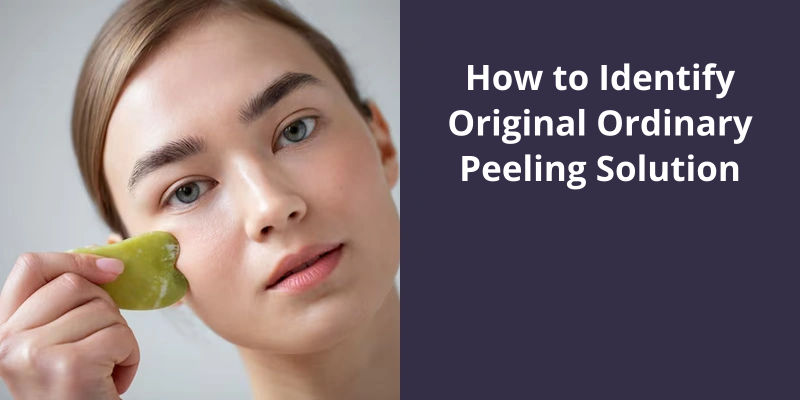Identifying an original Ordinary Peeling Solution involves several steps. Firstly, examine the packaging; it should have a clean, professional look and feel with no typos or mistakes in the text which indicates a good quality production process, a characteristic of the original product. Next, it should come sealed for your safety; open products can be a red flag. Also, the color of the authentic product is a deep red, almost like blood, resembling a cranberry color. If it is transparent or of any other color, it might be fake. Another important clue is the price – if it’s extraordinarily low, there’s a high chance it’s not genuine as The Ordinary skincare line, although affordable, is not cheap. Lastly, ensure you are purchasing from an authorized retailer which is a guaranteed way to get an original product.

Should I Leave Peeling Solution on Face?
The question of whether to leave a peeling solution on ones face is one that’s common, especially among those who’re new to using such products. The answer to this question isn’t a straightforward one, as it depends largely on the specific product being used, as well as an individuals skin type and sensitivity. However, it’s important to follow the instructions provided with the product and to be aware of any potential risks or adverse reactions.
This time may vary depending on the product, but it’s typically between five and twenty minutes. During this time, the solution may begin to dry down and feel a bit tacky on the skin. This is normal and is a sign that the product is working as intended. It’s important, however, to not leave the solution on for too long, as this can lead to skin irritation or other adverse reactions.
Different Types of Peeling Solutions Available in the Market
- Glycolic Acid Peels
- Lactic Acid Peels
- Mandelic Acid Peels
- Beta Hydroxy Acid (BHA) Peels
- Salicylic Acid Peels
- TCA (Trichloroacetic Acid) Peels
- Jessner’s Peel
- Retinoic Acid Peels
While The Ordinary peeling solution is known to have great benefits for the skin, it’s important to address concerns about skin bleaching. Many people wonder whether this popular product can lighten their skin too much or cause any unwanted effects. It’s essential to understand the ingredients and potential side effects of any skincare product before incorporating it into your routine. So, let’s dive deeper into the question: Does The Ordinary peeling solution bleach your skin?
Does the Ordinary Peeling Solution Bleach Your Skin?
However, there’s no evidence to suggest that this solution bleaches the skin. Bleaching agents like hydroquinone and kojic acid can lighten the skin by inhibiting melanin production, but AHA works by exfoliating the skin and promoting cell turnover. While this may lead to some temporary redness and peeling, it doesn’t alter the pigmentation of the skin.
It’s important to note that any peeling or exfoliating product can cause irritation or sensitivity in some individuals, especially those with sensitive skin or certain skin conditions. It’s recommended to patch test the product and start gradually with short application times before building up to a full treatment.
To further ensure the safety and efficacy of The Ordinary peeling solution, it’s recommended to follow the instructions carefully and use sunscreen daily to protect the skin from sun damage. Sun exposure can exacerbate the effects of acid exfoliation and increase the risk of damage or sensitivity.
Overall, The Ordinary peeling solution is a popular and effective skincare treatment for improving skin texture and brightening complexion. However, it’s important to approach any skincare product with caution and research to determine if it’s suitable for your individual skin type and concerns. Proper usage and protection can also help to achieve maximum benefits and minimize potential risks.
It’s important to note that when it comes to skincare, more isn’t always better. Understanding the recommended usage of a product can make all the difference in achieving the desired results without causing harm to your skin. In the case of The Ordinary’s peeling solution, it’s essential to follow their guidelines and start slow. Read on to discover more about the benefits of this product and how to use it effectively.
How Long Can I Use Ordinary Peeling Solution?
The Ordinary Peeling Solution has become quite popular among skincare enthusiasts for it’s ability to exfoliate the skin and improve it’s overall appearance. However, like any skincare product, it’s important to use it properly to avoid any negative side effects. The company recommends using it no more than twice a week, but that may not be suitable for everyone. It’s essential to listen to your skin and adjust your usage accordingly.
It’s also important to note that the Peeling Solution is a potent formulation, with a high concentration of AHAs and BHAs. It’s crucial to patch test the product before using it, as some people may experience adverse reactions. Start by using it only once a week, and gradually increase the frequency if your skin tolerates it well.
Limit your usage to no more than twice a week, and keep an eye out for any signs of irritation or discomfort. Above all, listen to your skin and adjust your routine accordingly.
Alternatives to the Ordinary Peeling Solution for Exfoliation
- Paula’s Choice 2% BHA Liquid Exfoliant
- The Inkey List PHA Toner
- COSRX AHA/BHA Clarifying Treatment Toner
- REN Ready Steady Glow Daily AHA Tonic
- The Ordinary Salicylic Acid 2% Masque
- Drunk Elephant T.L.C. Framboos Glycolic Resurfacing Night Serum
- Sunday Riley Good Genes All-In-One Lactic Acid Treatment
- Pixi Glow Tonic
- Biossance Squalane + Glycolic Renewal Facial
- Tatcha The Rice Polish Foaming Enzyme Powder
- First Aid Beauty Facial Radiance Pads
- Kate Somerville ExfoliKate Intensive Exfoliating Treatment
When it comes to skincare, authenticity is essential. Nobody wants to spend money on fake products that won’t benefit their skin. That’s why it’s important to know how to tell if your ordinary product is genuine. In this article, we’ll discuss how to detect the difference between the real deal and a counterfeit copy, specifically with The Ordinary products. One of the first things to look for is the packaging, followed by the text on the packaging.
How Do I Know if My Ordinary Product Is Original?
However, one thing to look out for is the consistency of the text. If it’s blurry or difficult to read, it may be a sign that the product isn’t genuine. Additionally, the font used should be consistent across all text on the packaging. Any variations could indicate a counterfeit version.
Another factor to consider is the price. If the price seems too good to be true, it likely is. The Ordinary prides itself on affordable pricing, but if the product youre considering is significantly cheaper than usual, it may be a fake. Be wary of buying from unauthorized retailers or online marketplaces, as they may sell counterfeit products.
When it comes to the product itself, there are a few things to look out for. The texture and scent should be consistent with other products from The Ordinary that you’ve used before. If it feels or smells different, it may be a fake. Additionally, the packaging should have clear labeling with ingredients listed in the correct order.
If youre still unsure about whether your product is genuine, there are a few resources you can turn to. The Ordinary has an official website where you can browse their products and packaging for reference. You can also reach out to their customer service team with any concerns or questions.
Finally, trust your instincts. If something seems off about the product or the retailer selling it, it’s better to err on the side of caution and not make the purchase. Ensuring that your Ordinary product is genuine will ensure youre getting the high-quality ingredients and formulas you know and love.
Source: Are you Worried that Your New The Ordinary Product is a Fake?
It’s important to understand why your skin is experiencing this reaction, and to take the necessary steps to support the healing and recovery process. In this article, we’ll explore some of the reasons why your skin may be red after using an ordinary peeling solution, as well as some tips and tricks for minimizing discomfort and achieving a faster turnaround time. So, let’s dive in!
Why Is My Skin Red After Ordinary Peeling Solution?
Peeling solutions are formulated with different types of acids, such as alpha-hydroxy acids (AHAs) and beta-hydroxy acids (BHAs), that penetrate the top layer of the skin and remove dead skin cells. However, these acids can also cause irritation and inflammation in some people, resulting in redness and sensitivity.
To minimize the risk of post-peel redness, it’s important to choose a peel that matches your skin type and concerns. For instance, if you’ve sensitive skin, it’s best to use a milder peel with lower acid concentration, such as glycolic or lactic acid. If you’ve oily or acne-prone skin, you may benefit from a stronger peel with salicylic or mandelic acid.
In addition to choosing the right peel, it’s crucial to follow the instructions carefully and avoid over-applying the solution. Leaving the peel on for too long or using it too frequently can also cause redness and other adverse reactions. It’s recommended to start with a patch test before applying the peel to the entire face, and to gradually increase the frequency and duration of use as your skin tolerates it.
If you do experience post-peel redness, there are several ways to soothe and calm your skin. Applying a cool compress or aloe vera gel can help reduce inflammation and redness. Avoiding exposure to sunlight and using a broad-spectrum sunscreen can also prevent further damage and irritation. In some cases, a dermatologist may recommend topical or oral medication to manage the symptoms and prevent infection.
Overall, post-peel redness is a common and expected side effect of using a peeling solution. It’s important to understand the causes of redness and take steps to minimize the risk and manage the symptoms. With proper care and attention, you can enjoy the benefits of a smoother, brighter, and more even-toned complexion.
Different Types of Peels: The Article Could Discuss the Different Types of Peels Available on the Market, Such as Enzyme Peels, Chemical Peels, and Physical Exfoliants. It Could Also Explain the Differences Between These Peels and What Skin Types They Are Most Suitable For.
Peels come in different types, including enzyme peels, chemical peels, and physical exfoliants. Each of these peels has unique characteristics that make them more suitable for certain skin types. This article explores the differences between these peels and provides some insight into the best type for your specific skin.
Watch this video on YouTube:
Conclusion
In conclusion, it’s important to be aware of the potential for counterfeit or fake products when purchasing any skincare product, including the ordinary peeling solution. While there are various ways to try and determine if a product is original, such as checking the packaging, scent, and consistency, the most effective way is to purchase from a reputable source. This may mean buying directly from the brand's website or an authorized retailer. Investing in authentic skincare products not only ensures that you’re getting the most effective and safe product, but also supports the integrity of the industry as a whole.





